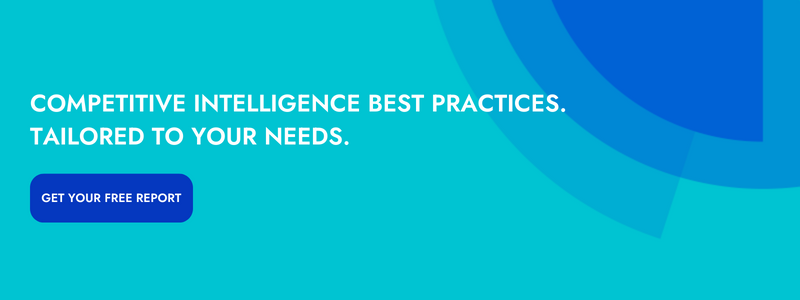For those who conduct competitive intelligence, gathering insights in a timely manner can be an enormous struggle. On any given day, there may be hundreds — if not thousands — of signals generated across your competitive landscape.
Even if you manage to keep track of everything, it can be difficult to determine (1) which insights are valuable and (2) how to go about inspiring action across your organization.
Although each organization is unique, there are plenty of competitive intelligence examples that apply to nearly everyone. Today, we’re going to walk through 10 such examples. Along the way, we’ll share advice for inspiring action in order to maximize the value of your efforts.
NEED COMPETITIVE INTELLIGENCE BEST PRACTICES? USE OUR FREE TOOL >>
10 essential examples of competitive intelligence
For clarity, please note that examples of competitive intelligence and sources of competitive intelligence are not the same thing. Competitors’ websites, third-party review platforms, win/loss analysis — each of these is a source, not an example.
1. Positioning/messaging changes
You must always understand — at least at a high level — how each of your competitors is defining and communicating their unique value. Otherwise, you and your colleagues will struggle to effectively differentiate your product.
That’s why it’s critical to stay on top of positioning and messaging changes. The longer it takes you to note and analyze these changes, the more likely you are to get blindsided.
Your competitors’ homepages and product pages are excellent places to start. If any of them makes an adjustment to their core value proposition, you’ll see it reflected in these places (and probably in plenty of other places, too).
Inspiring action across your organization
Many different people are responsible for communicating the unique value of your product — primarily sales, marketing, and customer success. At a minimum, each of these stakeholders should be alerted when one of your competitors initiates positioning and messaging changes. Sales and CS in particular need to be prepared to address new objections/talking points from prospects and customers that may arise as a result of these changes.
2. Pricing/packaging changes
In a competitive market, pricing and packaging can exert tremendous influence on buyers’ decisions. Everyone operates under some kind of budget constraint, and even if your product promises unbeatable ROI, there will be instances where business is lost to a competitor purely because they offer a lower price point.
You cannot minimize the frequency of those instances unless you keep track of where each competitor stands from a pricing and packaging perspective. Again, the last thing anyone wants is to get blindsided — either by a prospect going dark or by a customer churning.
You may be able to find your competitors’ pricing and packaging details directly on their websites. If not, you’ll need to rely primarily on field intelligence.
Inspiring action across your organization
As you may have inferred, sales and customer success should be made aware of pricing and packaging changes. If one of your competitors makes their product cheaper, both of these stakeholders need to be prepared to more effectively demonstrate/communicate ROI.
In some cases, it may be wise to alert product management and executive leadership, too. If a competitor initiates a pricing change that indicates movement towards a new customer segment (either upwards or downwards), those in charge of product strategy and business strategy will need to be in the loop.
3. Leadership changes
Speaking of executive leadership: It’s a good idea to keep track of C-suite personnel changes across your competitive landscape, as these changes often precede strategic shifts.
Say, for example, that one of your industry rivals hires their first SVP of Sales. Presumably, this person will be responsible, among other things, for taking your competitor’s sales team to the next level. As long as this person is halfway decent at their job, it won’t be long before your sales reps find themselves in an increasing number of competitive deals.
Alternatively, let’s say one of your competitors suddenly parts ways with their Chief Product Officer. Although we discourage jumping to conclusions in the absence of concrete evidence, this departure could be indicative of internal strife with respect to the product roadmap.
Inspiring action across your organization
How you take action on a competitor’s leadership change largely depends on the specifics of the situation. Ask yourself: What will be the major consequences of this change? Who needs to be prepared for these consequences?
In the case of a competitor hiring their first SVP of Sales, you need to (1) arm your sales reps with the collateral needed to win an increasing number of competitive deals and (2) arm your CS reps with the collateral needed to combat competitor-planted talking points. You might need to brief your own leaders as well, as they may want to execute some kind of plan to maintain healthy results on the bottom line.
4. News coverage
Whether it’s positive, negative, or neutral, you never want to miss news coverage regarding a competitor of yours. Much like a change in executive leadership, news coverage can signal a strategic shift. If, for example, your competitor earns coverage upon their announcement of a partnership with a trade association, that’s indicative of a shift in strategy when it comes to branding and demand generation.
In special cases, news coverage can also serve as a talking point that reinforces your value proposition. If, for example, your competitor earns coverage upon their announcement of a data breach, you and your colleagues may want to use that as proof of your superior security.
Inspiring action across your organization
Again, how you take action will largely depend on the specifics of the situation. If it’s coverage regarding a trade association partnership, sales and marketing are the primary stakeholders. If it’s coverage regarding an SEC filing, executive leadership is the primary stakeholder. And if it’s coverage regarding a product malfunction, practically every stakeholder should be alerted: sales and marketing for obvious reasons, as well as product management for purposes of testing and CS for purposes of reassuring your customers.
5. Website A/B tests
You can learn quite a bit by keeping track of your competitors’ website A/B tests. This is true for a number of reasons.
First things first: An A/B test can reveal a potential change in marketing strategy. For example, let’s say one of your competitors has long used “Get a Demo” as their primary homepage CTA. If, one day, you notice an experiment with an alternative CTA — “Start Your Free Trial” — that’s an indication that they’re considering a new approach to lead gen and qualification. The sooner you and your colleagues are aware of such an experiment, the better.
Plus, each A/B test conducted by one of your competitors is an opportunity to learn more about your prospects. If “Get a Demo” ultimately triumphs over “Start Your Free Trial” on your competitor’s homepage, it’s safe to conclude that the latter CTA was relatively unsuccessful. This conclusion points to something meaningful about your target audience: Demos are more appealing than free trials.
Inspiring action across your organization
Generally, in the case of website A/B tests, marketing is your primary stakeholder. That being said, which specific marketers you need to alert will often depend on the details of the test at hand. When a competitor experiments with an alternative homepage CTA, you’ll want to connect with your demand gen specialists, as the conclusion of this experiment will be of particular interest to them. Elsewhere, when a competitor experiments with an alternative resource page design, you’ll want to connect with your content specialists.
6. Customer reviews
Customer reviews of your competitors’ products (typically found on third-party websites) are gold mines of competitive intelligence. By consistently keeping track of what your competitors’ customers are saying about their products, you can get a picture of their respective strengths and weaknesses — and, by extension, a picture of your opportunities and threats.
The upside of tracking customer reviews is similar to the upside of tracking positioning and messaging changes: You’re able to stay on top of what each competitor is and is not bringing to market. With this knowledge, you and your colleagues are better equipped to create and communicate differentiated value. In other words, with the knowledge gleaned from customer reviews, your company as a whole is better equipped to build and maintain a competitive edge.
Inspiring action across your organization
Every stakeholder across your organization stands to benefit from your analysis of competitors’ customer reviews. As an example, let’s say your analysis of Competitor A’s customer reviews leads you to the conclusion that they’re failing to address a specific pain point. Executive leaders and product managers can incorporate this intel into their long-term strategy planning. Marketers can incorporate this intel into their positioning and messaging. Sales and CS reps can incorporate this intel into their conversations with prospects and customers.
7. Employee reviews
And while we’re on the topic of reviews: Don’t underestimate the power of tracking and analyzing the words of your competitors’ employees. Employee reviews, much like customer reviews, are gold mines of competitive intelligence.
In an indirect sort of way, employee reviews can provide amazing insight as to where a given company is and is not making the proper investments. Say, for example, that one of your competitors tends to get negative reviews from their engineers. “The lack of focus and direction from a product management perspective is beyond frustrating,” says one of them. Obviously, the end user experience delivered by this company is going to be sub-optimal — and likely remain that way for the foreseeable future.
Positive reviews can be just as informative, by the way. Say another one of your competitors tends to garner praise from their customer success reps. “The emphasis on personal growth and well-being makes for an amazing experience,” says one of them. It’s not a direct correlation, but a strong CS employee experience likely translates into a strong customer experience.
Inspiring action across your organization
As is the case with customer reviews, practically every stakeholder can benefit from your analysis of competitors’ employee reviews. In the case of a competitor with chronically frustrated engineers, executives can seize the opportunity to create the industry-leading employee experience, and product managers can seize the opportunity to create the industry-leading end user experience. Meanwhile, marketing, sales, and customer success can incorporate this intel into prospect- and customer-facing messaging.
8. Job postings
From a competitive intelligence perspective, job postings offer insights similar to those offered by employee reviews — i.e., insights related to your competitors’ internal investments (or lack thereof). By consistently keeping track of the positions for which your competitors are hiring, you can get a picture of where they are and are not focusing their resources.
In some cases, you may find opportunities to use this intelligence in tandem with insights gleaned from employee reviews. Once again, we’ll use the example of a competitor with engineers who are frustrated by unfocused product management. One month after your analysis of their negative employee reviews, you notice that this competitor posts an open VP of Product Management role on their website. This is likely a sign that they’re working to get their product roadmap back on track — something you and your colleagues should be mindful of.
Inspiring action across your organization
As is the case with leadership changes, you should ask yourself: What is your competitor trying to achieve by hiring for the position they just posted on their website? Who at your company needs to be prepared for this?
If your competitor is hiring for a video marketing position, they’re clearly trying to grow their presence on platforms like YouTube. Your marketing team, especially the content specialists, should prepare for this. Elsewhere, if another competitor is hiring for a sales enablement position, they’re clearly trying to win more deals. Your sales team — as well as your product marketers — should prepare for this.
9. Customer logo changes
Assuming you’re competing with more than one company, it’s critical that you’re the first to know when one of your competitors loses a key account. Otherwise, by the time you do realize that this prospective customer is back on the market, it may be too late — they may already have a strong relationship with another organization.
As such, it’s a good idea to closely monitor the customer logos on each of your competitors’ websites. That way, whenever a marquee logo is quietly removed from a rival homepage, you’ll be able to investigate the opportunity before anyone else even knows it exists.
And in the same way that job postings can be analyzed in tandem with employee reviews, customer logo changes can be analyzed in tandem with customer reviews. If you come across a lukewarm or negative review from one of the companies featured on a competitor’s homepage, keep an eye on that logo — you may soon have a golden opportunity to investigate.
Inspiring action across your organization
Generally, sales and marketing are the primary stakeholders when it comes to competitors removing key logos from their websites. Sales reps, of course, are the ones who will try to turn these newly available prospects into customers. Marketers, specifically demand gen specialists, can assist in this effort by putting together email campaigns.
In some cases, however, executive leadership will also need to be notified. If, over time, you were to notice one of your competitors gradually replacing mid-sized company logos with enterprise company logos, that would likely indicate their shift to a new customer segment.
10. Content updates
You need to be aware not only when competitors expand to new customer segments — i.e., from SMBs and mid-sized companies to enterprises — but also when they expand to new buyer personas. If, unbeknownst to you, rival companies begin marketing to a wider range of target customers, the consequences from a market share perspective could be devastating.
One way to avoid getting blindsided: Pay attention to your competitors’ content updates. The subject matter of a company’s prospect-facing content is almost always going to be reflective of their buyer personas. Companies that write for security specialists sell to security specialists. Companies that write for researchers sell to researchers. Companies that write for developers sell to developers. You get the idea.
If, over time, you notice one of your competitors seems to be creating content that’s geared toward a new buyer persona, it’s probably worthwhile to investigate further.
Inspiring action across your organization
As is the case when a competitor expands to a new customer segment, a competitor expanding to a new buyer persona warrants discussion with your executive team. As the people in charge of ensuring the long-term viability of your company, they’re going to need to be in the loop. Also in the loop should be marketing and product management, considering the centrality of buyer personas to their everyday work. Finally, you’ll want to connect with your sales team, as the notion of this competitor selling to a wider range of people within target accounts will almost certainly have an impact on their day-to-day.
Communication is one of the major keys to CI success
The goal of this guide was not only to walk through examples of competitive intelligence, but also to make clear the importance of communication. Tracking your competitors’ movements is an extraordinarily important job, but in the absence of organization-wide action, what’s the use in expending all that energy?
If you want to systematically convert your competitive intelligence efforts into bottom-line results, you need to communicate with each and every one of your stakeholders — sales, marketing, product management, customer success, and executive leadership. The more involved everyone is, the more success everyone will enjoy.




